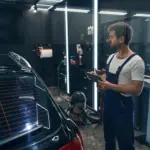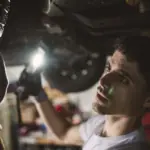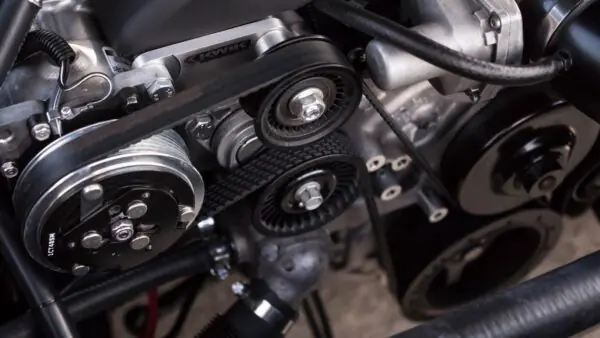10 Car Tips final
Here are ten basic things every driver should do to their vehicle. It is all right if you’re not an automotive engineer. Of course, if you are, this information probably isn’t for you because there are ten basic things every motorist should be able to do. Unobstructed visibility is critical to safe driving, helping ensure your vehicle’s windshield is clear of precipitation and road grime is washer fluid. Keep the reservoir filled with plenty of this refreshing-looking but poisonous liquid. Just pop the hood and look for the refill cap. They’re usually blue for easy spotting. Then let’s pop it off and top up, but fluid is only half the equation. Sporadically, you will require a new arrangement of windshield wiper cutting edges, which is, obviously, point number nine on this rundown. Luckily, it’s also an easy task to swap them as they essentially clip into place to release a blade. There’s often a small button that you push. Other times, they slide into a hook on the end of the arm. The blade shouldn’t be overly difficult to swap out. So give it a try next time they are smearing rather than wiping. Hmm, that sounds like a bathroom joke. LOL, Another mission-critical vehicle component is engine oil, and it’s super easy to check provided you don’t own electric cars as they lack crankcases full of lubricant or a modern BMW, which of course, don’t have dipsticks. Keeping an eye on the oil is a snap. Ensure the vehicle is perched on a somewhat level surface. If you just left it, stand by a couple of moments, as the oil might not have totally depleted once more into the container, which could bring about a misleading perusing.
With all that far removed, haul the dipstick out, clear it off with a cloth or piece of paper towel and stick it back into the cylinder from whence it came. Then pull it out again and read the level. You’re good to go if the oil level shows between the low and full marks. An overabundance of oil in an engine can be just as bad as insufficient. It can lead to aeration and many other issues. So basically, keep it between the marks, and you should be all set. But if the engine is low on lube, every driver should also be able to top off the crankcase. Just locate the filler cap. Then pour a bit of oil down in there. Make sure it’s the correct viscosity. Wait a minute or so and recheck the dipstick to avoid overfilling. Add small amounts until the correct level is achieved. Car engines typically take between four and five quarts, although this varies. A RAM 3500 truck with the coming straight six diesel requires three gallons of oil! Just check the owner’s manual or workshop manuals for specific details. But taking this a step further, you could also change the oil and filter, which usually isn’t that difficult. Do it yourself. Next, talk about the only part of your vehicle that should ever touch the road. Yes, that would be the tires. Point number six, all motorists should be able to check their tire pressure. Remove the valve stem cap and firmly stick a gauge over the end. Ensure it seats well so no air leaks around the edges, which could lead to an inaccurate measurement. Unless there are special circumstances, it’s best to maintain the factory-recommended pressure displayed on a placard, usually near the driver’s side door jam. Inflate or deflate as required. And while we’re in this area, every driver should be able to change a flat tire. Unfortunately, temporary spares have become less and less common, replaced by space and weight-saving emergency inflation kits. Still, the ability to jack a vehicle up, remove an offending flat and install a spare tire is an important skill, especially if you get a flat where cell phone service is unavailable. And remember, that’s a righty and lefty lucy. Just strip the threads and back off half a term, and you’ll be fine. Also, add major bonus points if you can rotate those tires, a process that’s a bit more time-consuming, though the payoff, of course, is prolonged tire life. If your car is newer, you’ll probably have to reprogram the tire pressure monitoring system to show where each tire is located accurately. Now, point number four on this list of things is every motorist should be able to jump-start a vehicle with a dead battery. Of course, this requires a set of jumper cables, a car or a truck that’s fully charged, and a little bit of know-how. Please ensure you do not mix up the leads. A positive terminal must connect to a positive terminal, negative to negative. If you switch them around, terrible things will happen. A helpful hint to prevent this is that red is associated with positive, and black with negative in modern vehicles. The negative cable doesn’t necessarily have to connect directly to the battery as the negative side is grounded to the engine and body structure, so an engine bracket or metal part of the body will work just as well as a terminal. But if you’re in doubt, go for the battery. And fresh air is a wonderful thing. It’s as necessary to life as it is to your engine. You see, internal combustion cannot occur without a free-flowing supply of oxygen. It is important to regularly check the air filter. Reducing your engine’s output. But the great news is they’re usually cheap and relatively easy to replace. This will vary, but in many modern cars and trucks, the air filter is found underneath a large rectangular housing, with the lid held by screws or clips. In either case, pop it off to access the filter itself. The new element should drop right in, but make sure to orient it in the same way as the old one. The wrinkles must face the incoming air to capture as much dirt as possible. Many vehicles are also equipped with cabin air filters, which clean the air before entering the system. Depending on make and model, these can be easier or much harder to replace than an engineered filter, but give yourself even more bonus points if you’re capable of this maintenance item. Next up, point two, every driver should be able to inspect their car or truck Serpentine Belt, provided the part in question isn’t concealed by layer after layer of plastic shrouds. It should be a snap to give a quick once over if the belt shows heavy abrasion cracking across the grooves, lengthwise tearing or other obvious signs of damage. You’ll want to replace it sooner than later and award yourself some super bonus points if you can tackle this job independently. In theory, the process is simple, but it often feels like you need two extra sets of hands to position the belt exactly where it needs to be with the tension release. And remember, proper routing is critical for all accessories to function. Finally, every driver out there should be able to give their engine’s cooling system a good once over, critically important yet often ignored like that exercise equipment you bought around the holidays in 2006. Cooling systems have to cope with scorching summer heat and Arctic cold. Keep an eye out for swelling, chafed, cracked or weeping hoses. They are fixing to burst, which will leave you stranded. Also, make sure there’s enough coolant in the overflow reservoir. Add more as required. The cooling system must be flushed out if the antifreeze is discolored or rusty. Something you can do yourself if you fancy earning even more bonus points. And there you have ten simple vehicle maintenance items every driver should be able to tackle.









